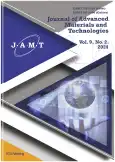Estimation of graphene layers number and defectiveness of few-layered graphene particles by Raman spectroscopy
- Авторлар: Goncharova N.N.1, Samoilov V.M.1, Elchaninova V.A.1, Nakhodnova A.V.1, Danilov E.A.1, Tarasov K.A.1
-
Мекемелер:
- NIIgraphite – Research and Development Institute of Graphite-Based Structural Materials
- Шығарылым: Том 9, № 2 (2024)
- Беттер: 84-90
- Бөлім: Original papers
- URL: https://journal-vniispk.ru/2782-2192/article/view/279620
- DOI: https://doi.org/10.17277/jamt.2024.02.pp.084-090
- ID: 279620
Дәйексөз келтіру
Толық мәтін
Аннотация
The purpose of the present work is to develop methods for assessing the quality of aqueous suspensions of few-layered graphenes using Raman spectroscopy technique. Aqueous suspensions of few-layered graphene particles were manufactured by direct exfoliation of natural graphite under with ultrasound in the presence of surfactants. An experimental assessment of the effectiveness of different methods of Raman spectroscopy data analysis in order to determine the average number of graphene layers and the defectiveness of few-layered graphene particles was carried out. It is concluded that it is possible to determine the average number of graphene layers in aqueous suspensions of few-layer graphene particles based on the ratio of integral intensities and the position of the G and 2D peaks. Additionally, it is proposed to use the ratio of the peaks of the integrated intensities of peaks D and G as a parameter characterizing the defectiveness of particles of few-layered graphenes. Examples are given of using this approach to assess the quality of graphene samples obtained using various technologies via averaged distribution functions of the number of layers in particles and the ID/IG ratio. It was shown that samples with minimal amount of layers had minimal particle size and high defectivity, while samples with higher number of layers had larger particle size with low defectivity.
Авторлар туралы
Nataliya Goncharova
NIIgraphite – Research and Development Institute of Graphite-Based Structural Materials
Email: NNiGoncharova@rosatom.ru
ORCID iD: 0009-0003-6722-1246
Head of the Laboratory
Ресей, 2, Electrodnaya St., Moscow, 111524Vladimir Samoilov
NIIgraphite – Research and Development Institute of Graphite-Based Structural Materials
Хат алмасуға жауапты Автор.
Email: VMSamoylov@rosatom.ru
ORCID iD: 0000-0002-9861-905X
D. Sc. (Eng.), Professor, Chief Researcher
Ресей, 2, Electrodnaya St., Moscow, 111524Viktoriya Elchaninova
NIIgraphite – Research and Development Institute of Graphite-Based Structural Materials
Email: viaelchaninova@rosatom.ru
ORCID iD: 0009-0006-3167-8924
Researcher
Ресей, 2, Electrodnaya St., Moscow, 111524Anastasiya Nakhodnova
NIIgraphite – Research and Development Institute of Graphite-Based Structural Materials
Email: AVNakhodnova@rosatom.ru
Cand. Sc. (Eng.), Head of the Testing Center
Ресей, 2, Electrodnaya St., Moscow, 111524Egor Danilov
NIIgraphite – Research and Development Institute of Graphite-Based Structural Materials
Email: egadanilov@rosatom.ru
ORCID iD: 0000-0002-1986-3936
Cand. Sc. (Chem.), Head of the Laboratory
Ресей, 2, Electrodnaya St., Moscow, 111524Konstantin Tarasov
NIIgraphite – Research and Development Institute of Graphite-Based Structural Materials
Email: KoATarasov@rosatom.ru
ORCID iD: 0009-0006-2942-6365
Engineer
Ресей, 2, Electrodnaya St., Moscow, 111524Әдебиет тізімі
- Tuinstra F, Koenig JL. Raman spectrum of graphite. Journal of Chemical Physics. 1970;53(3):1126-1130. doi: 10.1063/1.1674108
- Cançado LG, Takai K, Enoki T, Endo M, et al. Measuring the degree of stacking order in graphite by Raman spectroscopy. Carbon. 2008;46(2):272-275. doi: 10.1016/j.carbon.2007.11.015
- Ferrari AC, Robertson J. Interpretation of Raman spectra of disordered and amorphous carbon. Physical Review B. 2000;61(20):14095-14107. doi: 10.1103/PhysRevB.61.14095
- Ferrari AC, Meyer JC, Scardaci V, Casiraghi C, et al. Raman spectrum of graphene and graphene layers. Physical Review Letters. 2006;97(18). doi: 10.1103/PhysRevLett.97.187401
- Wu JB, Lin ML, Cong X, Liu HN, Tan PH. Raman spectroscopy of graphene-based materials and its applications in related devices. Chemical Society Reviews. 2018;47(5):1822-1873. doi: 10.1039/C6CS00915H
- Das A, Chakraborty B, Sood AK. Raman spectroscopy of graphene on different substrates and influence of defects. Bulletin of Materials Science. 2008;31(3):579-584. doi: 10.1007/s12034-008-0090-5
- Gupta A, Chen G, Joshi P, Tadigadapa S, Eklund PC. Raman scattering from high-frequency phonons in supported n-graphene layer films. Nano Letters. 2006;6(12):2667-2673. doi: 10.1021/nl061420a
- Zhu W, Dimitrakopoulos C, Freitag M, Avouris P. Layer number determination and thickness-dependent properties of graphene grown on SiC. IEEE Transactions on Nanotechnology. 2011;10(5):1196-1201. doi: 10.1109/TNANO.2011.2130536
- Graf D, Molitor F, Ensslin K, Stampfer C, et al. Spatially resolved Raman spectroscopy of single- and few-layer graphene. Nano Letters. 2007;7(2):238-242. doi: 10.1021/nl061702a
- Holmi J. Determining the number of graphene layers by Raman-based Si-peak analysis. Available from: https://core.ac.uk/download/pdf/80719206.pdf [Accessed 11 March 2024]
- Kumar V, Kumar A, Lee DJ, Park SS. Estimation of number of graphene layers using different methods: a focused review. Materials. 2021;14. doi: 10.3390/ma14164590
- Dresselhaus MS, Dresselhaus G, Eklund PC. Raman scattering in fullerenes. Journal of Raman Spectroscopy. 1996;27(3-4):351-371. doi: 10.1002/(SICI)1097-4555(199603)27:3/4<351::AID-JRS969>3.0.CO;2-N
- Kuzmany H, Pfeiffer R, Hulman M, Kramberger C. Raman spectroscopy of fullerenes and fullerene-nanotube composites. Philosophical Transactions of the Royal Society of London. Series A: Mathematical, Physical and Engineering Sciences. 2004;362(1824):2375-2406. doi: 10.1098/rsta.2004.1446
- Dresselhaus MS, Dresselhaus G, Jorio A, Souza Filho AG, Saito R. Raman spectroscopy on isolated single wall carbon nanotubes. Carbon. 2002;40(12):2043-2061. doi: 10.1016/S0008-6223(02)00066-0
- Wang Y, Vasileva D, Zustiak SP, Kuljanishvili I. Raman spectroscopy enabled investigation of carbon nanotubes quality upon dispersion in aqueous environments. Biointerphases. 2017;12(1). doi: 10.1116/1.4978922
- El-Mashtoly SF. 2nd ed. Confocal Raman Microscopy. In: Toporski J, Dieing Th, Hollricher O. (eds.) New York: Springer; 2018. 596 p. doi: 10.1017/S1431927619014880
- Kovtun A, Treossi E, Mirotta N, Scida A, et al. Benchmarking of graphene-based materials: real commercial products vs. ideal graphene. 2D Materials. 2019;6:025006. doi: 10.1088/2053-1583/aafc6e
Қосымша файлдар









